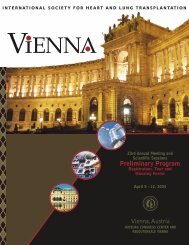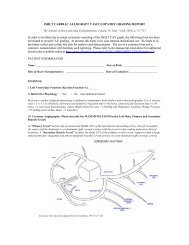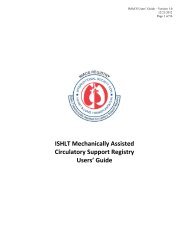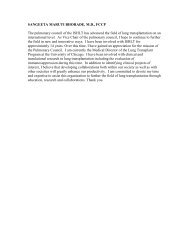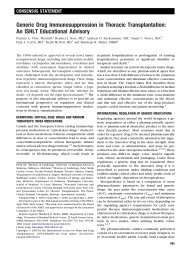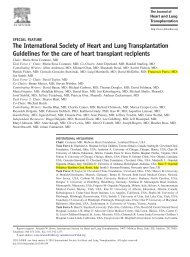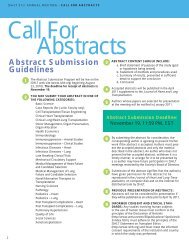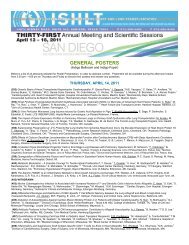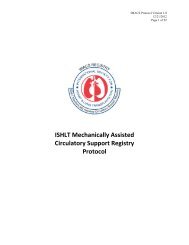Task Force 4: Inpatient Management of Patients with MCSD - The ...
Task Force 4: Inpatient Management of Patients with MCSD - The ...
Task Force 4: Inpatient Management of Patients with MCSD - The ...
You also want an ePaper? Increase the reach of your titles
YUMPU automatically turns print PDFs into web optimized ePapers that Google loves.
could be actuated <strong>with</strong> a hand pump or pneumatic driver, there is no way to manually or<br />
externally actuate the continuous pump once it is stopped and cannot be restarted. If<br />
blood remains stagnant in the pump for a period <strong>of</strong> time, there is a risk <strong>of</strong> thrombus<br />
formation and embolization should the pump be restarted. For patients who are “pump<br />
dependent” <strong>with</strong> little residual cardiac function, sudden stoppage may result in death. In<br />
addition, there is backflow <strong>of</strong> blood through the valveless outflow cannula creating a<br />
situation comparable to free aortic insufficiency, adding a further volume load to the<br />
unsupported ventricle. In cases where there is residual cardiac function, the patient may<br />
survive if able to reach medical attention rapidly. In this scenario, the patient is treated<br />
for cardiogenic shock and may require inotropic and other supportive measures until<br />
they can be transported back to the implanting medical center. In cases where the<br />
patient cannot undergo surgery, the outflow cannula may be percutaneously occluded<br />
as a temporizing measure to stem the backflow through the outflow cannula. 98,99<br />
Ultimately, however, surgical pump exchange is the definitive therapy, as permitted by<br />
the clinical status <strong>of</strong> the patient and ability to survive re-operation. In less acute<br />
situations where the pump is functioning but there are pump alarms or changes in pump<br />
parameters that cannot be resolved as an outpatient, the patient may need to be<br />
admitted for observation and close monitoring.<br />
Recommendations for Device Failure and Malfunction:<br />
Class I:<br />
1. Pump stoppage <strong>of</strong> a continuous flow <strong>MCSD</strong> constitutes a medical emergency, and<br />
the patient should be rapidly transported back to the implanting or other expert<br />
<strong>MCSD</strong> center for treatment.<br />
Level <strong>of</strong> Evidence: C.<br />
2. For patients who are unable to undergo surgery, the outflow cannula may be<br />
occluded percutaneously to halt the backflow <strong>of</strong> blood through the valveless outflow<br />
cannula as a stabilizing maneuver.<br />
Level <strong>of</strong> Evidence: B.<br />
3. Definitive therapy for pump stoppage is surgical pump exchange if the patient is<br />
stable enough to undergo re-operation.<br />
37





